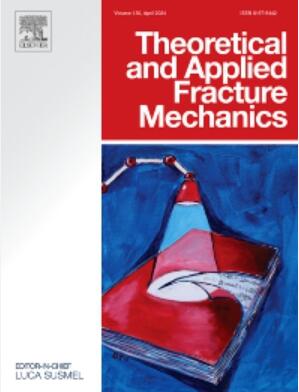Fracture process zone of dynamic cracks in brittle materials based on material configurational mechanics
IF 5
2区 工程技术
Q1 ENGINEERING, MECHANICAL
引用次数: 0
Abstract
This study investigates the dynamic crack tip fracture process zone (FPZ) by combining dynamic fracture mechanics and material configurational mechanics. The theory of configurational forces is developed within the non-linear dynamic framework, derived from the linear momentum balance equation. Configurational stress for dynamic cracks is estimated, and three J-integrals are calculated. A comprehensive framework is proposed to predict FPZs for both static and dynamic cracks. FPZ predictions are conducted employing Mises yield criterion and maximum normal stress criteria, applied to both Cauchy stress and configurational stress. The impact of crack speed and crack length on the FPZ is systematically analyzed. The predicted plastic zones or process zones align well with experimental photoelastic observations. Notably, the FPZs are observed to increase with increasing crack speed for a moving Griffith crack. Finally, the velocity factors significantly influence the FPZs for propagating cracks. The FPZs typically decrease with increasing crack speed and crack length for propagating cracks.
基于材料构形力学的脆性材料动态裂纹断裂过程区
结合动态断裂力学和材料组态力学对动态裂纹尖端断裂过程区进行了研究。构型力理论是在非线性动力学框架下发展起来的,由线性动量平衡方程推导而来。估计了动态裂纹的结构应力,计算了三个j积分。提出了一个综合的框架来预测静态和动态裂缝的fpz。FPZ预测采用Mises屈服准则和最大法向应力准则,适用于柯西应力和构型应力。系统地分析了裂纹速度和裂纹长度对FPZ的影响。预测的塑性区或过程区与实验光弹性观察结果很好地吻合。值得注意的是,对于移动的Griffith裂纹,fpz随裂纹速度的增加而增加。最后,速度因素对裂纹扩展速度的影响显著。随着裂纹扩展速度的增加和裂纹长度的增加,fpz通常会减小。
本文章由计算机程序翻译,如有差异,请以英文原文为准。
求助全文
约1分钟内获得全文
求助全文
来源期刊

Theoretical and Applied Fracture Mechanics
工程技术-工程:机械
CiteScore
8.40
自引率
18.90%
发文量
435
审稿时长
37 days
期刊介绍:
Theoretical and Applied Fracture Mechanics'' aims & scopes have been re-designed to cover both the theoretical, applied, and numerical aspects associated with those cracking related phenomena taking place, at a micro-, meso-, and macroscopic level, in materials/components/structures of any kind.
The journal aims to cover the cracking/mechanical behaviour of materials/components/structures in those situations involving both time-independent and time-dependent system of external forces/moments (such as, for instance, quasi-static, impulsive, impact, blasting, creep, contact, and fatigue loading). Since, under the above circumstances, the mechanical behaviour of cracked materials/components/structures is also affected by the environmental conditions, the journal would consider also those theoretical/experimental research works investigating the effect of external variables such as, for instance, the effect of corrosive environments as well as of high/low-temperature.
 求助内容:
求助内容: 应助结果提醒方式:
应助结果提醒方式:


